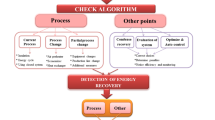Abstract
In the industrial production, approaches for the optimization of process chains mainly focus on criteria like quality, costs and time. Normally the energy consumption of process chains is not considered, although the variation of process parameters is an important possibility to reduce the consumption significantly. Besides that, the investigated processes are often optimized locally without considering the interaction between the different process elements of the whole process chain. Based on this background the developed concept realizes the optimization of the energy consumption of a forging process chain by adaptation of its energetic relevant parameters. Therefore, the concept defines at first variation intervals for the energetic most significant parameters of a forging process chain. After that, the resulting technical/technological modifications are evaluated energetically. To enable a holistic optimization of the process chain, the approach includes the use of a simulation model. The application of the concept has been approved with a simulation model of a 4-cylinder-crankshaft process chain. With the parameter variations “reduction of the forging temperature”, “reduction of the raw part volume” and “reduction of the forging time” three possibilities to reduce the energy consumption were identified successfully.
Similar content being viewed by others
References
Neugebauer, R., “Energy-Efficient Product and Process Innovations in Production Engineering,” CIRP Journal of Manufacturing Science and Technology, Vol. 4, No. 2, pp. 127–128, 2011.
Denkena, B., Henjes, J., and Henning, H., “Simulation-based dimensioning of manufacturing process chains,” CIRP Journal of Manufacturing Science and Technology, Vol. 4, No. 1, pp. 9–14, 2011.
Tönshoff, H. K. and Denkena, B., “Dubbel — Taschenbuch für den Maschinenbau, Übersicht über die Fertigungsverfahren,” Springer, 2011.
Lee, J. Y., Kang, H. S., and Noh, S. D., “Simulation-based Analysis for Sustainability of Manufacturing System,” Int. J. Precis. Eng. Manuf., Vol. 13, No. 7, pp. 1221–1230, 2012.
Denkena, B., Henjes, J., and Henning, H., “Holistic Process Chain Optimisation based on Simulation of Technological Interfaces,” 3rd International Conference on CARV, pp. 867–876, 2009.
Denkena, B., Behrens, B. A., Charlin, F., and Dannenberg, M., “Integrative process chain optimization using a Genetic Algorithm,” Production Engineering, Vol. 6, No. 1, pp. 29–37, 2012.
Larek, R., Brinksmeier, E., Meyer, D., Pawletta, T., and Hagendorf, O., “A discrete-event simulation approach to predict power consumption in machining processes,” Production Engineering, Vol. 5, No. 5, pp. 575–579, 2011.
Denkena, B., Flöter, F., and Hülsemeyer, L., “Enery-Efficient machine tools and technologies,” The 15th International Machine Tool Engineers’ Conference, Tokyo, 2nd–3rd, 2012.
Müller, E., Engelmann, J., Löffler, T., and Strauch, J., “Energieeffiziente Fabriken planen und betreiben,” Springer, 2009.
ISO/EN/DIN 14040, “Environmental management, life cycle assessment, principles and framework,” 2006.
ISO/EN/DIN 14044, “Environmental management, life cycle assessment, requirements and guidelines,” 2006.
Göschel, A., Sterzing, A., and Schönherr, J., “Balancing procedure for energy and material flows in sheet metal forming,” CIRP Journal of Manufacturing Science and Technology, Vol. 4, No. 2, pp. 170–179, 2011.
Denkena, B., Dang, X. P., Henjes, J., Lüken, I., and Park, H. S., “A study on the in-line induction heating process prior to forging in terms of saving operating energy,” International Symposium on Green Manufacturing and Applications (ISGMA), Seoul, 2011.
Park, H. S. and Dang, X. P., “Optimization of the In-line Induction Heating Process for Hot Forging in Terms of Saving Operating Energy,” Int. J. Precis. Eng. Manuf., Vol. 13, No. 7, pp. 1085–1093, 2012.
Doege, E. and Behrens, B. A., “Handbuch Umformtechnik — Grundlagen Technologien Maschinen,” Springer, 2007.
Böhm, V., Bruchwald, O., Reimche, W., Bach, W., Behrens, B. A., and Odening, D., “Acoustic Process Monitoring during Transient Precision Forging of High Strength Components,” Metallurgical and Mining Industry / Plastic Deformation of Metals — IX International Scientific and Technical Conference, No. 7, Vol. 3, 2011.
Behrens, B. A., Bouguecha, A., Lüken, I., and Klassen, A., “Numerische Auslegung der Kühlschmiermenge für Warmmassivumformprozesse,” METALL, Giesel Verlag GmbH, 2011.
Behrens, B. A., Frischkorn, C., and Lüken, I., “Development of an innovative monitoring system for spray fields in hot forging processes,” Production Engineering, 2012.
Klocke, F., Beck, T., Hoppe, S., Krieg, T., Müller, N., Nöthe, T., Raedt, H. W., and Sweeney, K., “Examples of FEM applications in manufactering technology,” Journal of Material Processing Technology, Vol. 120, No. 1-3, pp. 450–457, 2002.
Vazquez, V. and Altan, T., “New concepts in die design — physical and computer modeling applications,” Journal oif Material Processing Technology, Vol. 98, No. 2, pp. 212–223, 2000.
Behrens, B. A., Bach, Fr. W., Bouguecha, A., Nürnberger, F., Schaper, M., Yu, Z., and Klassen, A., “Numerische Berechnung einer intergrierten Wärmebehandlung für präzisionsgeschmiedete Bauteile,” Heat Treatment Materials, Vol. 67, pp. 337–343, 2012.
Jeong, D. J., Kim, D. J., Kim, J. H., Kim, B. M., and Dean, T. A., “Effects of surface teratments and lubricants for warm forging die life,” Journal of Materials Proecesing Technology, Vol. 113, No. 1-3, pp. 544–550, 2001.
Behrens, B. A., Bouguecha, A., Hadifi, T., and Klassen, A., “Numerical and Experimental Investigations on the Service Life Estimation for Hot-Forging Dies,” Key Engineering Materials, Vol. 504-506, pp. 163–168, 2012.
Painter, B., Shivpuri, R., and Altan, T., “Prediction of die wear during hot-extrusion of engine valves,” Journal of Materials Processing Technology, Vol. 59, No. 1-2, pp. 132–143, 1996.
Deutsche Edelstahlwerke GmbH, “Datenblatt 1.7225/1.7227 — 42CrMo4/42CrMoS4,” Witten, 2011.
Author information
Authors and Affiliations
Corresponding author
Rights and permissions
About this article
Cite this article
Denkena, B., Park, HS., Behrens, BA. et al. Development of a concept to optimize the energy efficiency in forging process chains. Int. J. Precis. Eng. Manuf. 14, 1229–1236 (2013). https://doi.org/10.1007/s12541-013-0167-y
Received:
Accepted:
Published:
Issue Date:
DOI: https://doi.org/10.1007/s12541-013-0167-y




